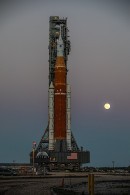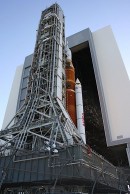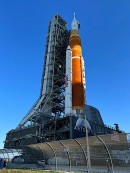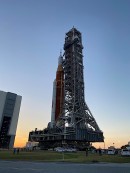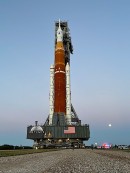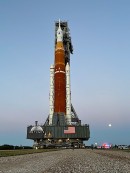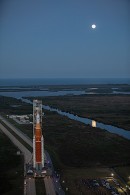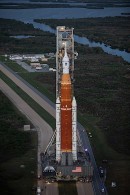Things don’t seem to be looking very great for the Space Launch System (SLS) rocket, as it once again failed to successfully and fully conclude the wet dress rehearsal test.
When it comes to space exploration, tests and failures are commonplace, but we’re pretty confident in saying NASA rocket scientists were hoping for a smooth run of this crucial test, that would have opened the doors to the first mission of the Artemis Moon exploration program.
That crucial run was the aforementioned wet dress rehearsal test, which, in a nutshell, required NASA to fill the thing's tanks with 700,000 gallons of cryogenic fuel (liquid hydrogen and liquid oxygen) and see if it stays in there. A mock countdown was to follow, then the draining of the fuel.
At the end of March, NASA had the first attempt to run the test. A technical glitch with the platform the rocket rests on caused it to be postponed until April 4. That day was not to go down in history as the one when success was achieved, as a temperature limit issue for the liquid oxygen delayed the countdown for several hours, then another glitch, with a pressure regulating valve on the mobile launcher, forced the agency to scrub the test.
From that day until April 14, engineers have tried to sort things out, and most of the existing issues seem to have been fixed. But then another one surfaced.
This time, the wet dress rehearsal concluded after a liquid hydrogen leak was noticed on the tail service mast umbilical. That’s the 33-feet tall thingy that connects from the zero-level deck on the mobile launcher to the SLS rocket core stage aft section, and holds liquid oxygen and liquid hydrogen fluid lines and electrical cable connections.
On the bright side, NASA says that before ending the test, “teams also met test objectives for the interim cryogenic propulsion stage by chilling down the lines used to load propellant into the upper stage.” That stopped short of being fully achieved as well, on account of the issue with the valve which we mentioned earlier.
It's unclear, at this time, how the agency plans to go forward with this. A briefing is scheduled for later today, and we’ll update accordingly.
That crucial run was the aforementioned wet dress rehearsal test, which, in a nutshell, required NASA to fill the thing's tanks with 700,000 gallons of cryogenic fuel (liquid hydrogen and liquid oxygen) and see if it stays in there. A mock countdown was to follow, then the draining of the fuel.
At the end of March, NASA had the first attempt to run the test. A technical glitch with the platform the rocket rests on caused it to be postponed until April 4. That day was not to go down in history as the one when success was achieved, as a temperature limit issue for the liquid oxygen delayed the countdown for several hours, then another glitch, with a pressure regulating valve on the mobile launcher, forced the agency to scrub the test.
From that day until April 14, engineers have tried to sort things out, and most of the existing issues seem to have been fixed. But then another one surfaced.
This time, the wet dress rehearsal concluded after a liquid hydrogen leak was noticed on the tail service mast umbilical. That’s the 33-feet tall thingy that connects from the zero-level deck on the mobile launcher to the SLS rocket core stage aft section, and holds liquid oxygen and liquid hydrogen fluid lines and electrical cable connections.
On the bright side, NASA says that before ending the test, “teams also met test objectives for the interim cryogenic propulsion stage by chilling down the lines used to load propellant into the upper stage.” That stopped short of being fully achieved as well, on account of the issue with the valve which we mentioned earlier.
It's unclear, at this time, how the agency plans to go forward with this. A briefing is scheduled for later today, and we’ll update accordingly.


